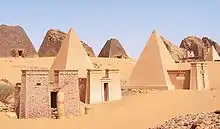Kingdom of Kush
The Kingdom of Kush (/kʊʃ, kʌʃ/; Egyptian: 𓎡𓄿𓈙𓈉 kꜣš, Assyrian: ![]() Ku-u-si, in LXX Ancient Greek: Κυς and Κυσι; Coptic: ⲉϭⲱϣ; Hebrew: כּוּשׁ) was an ancient kingdom in Nubia, centered along the Nile Valley in what is now northern Sudan and southern Egypt.
Ku-u-si, in LXX Ancient Greek: Κυς and Κυσι; Coptic: ⲉϭⲱϣ; Hebrew: כּוּשׁ) was an ancient kingdom in Nubia, centered along the Nile Valley in what is now northern Sudan and southern Egypt.
Kingdom of Kush | |||||||||||||||||
|---|---|---|---|---|---|---|---|---|---|---|---|---|---|---|---|---|---|
| c. 1070 BC – c. 350 AD | |||||||||||||||||
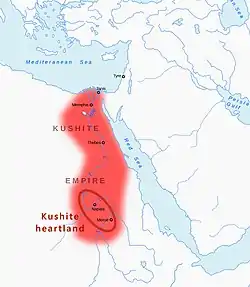 Kushite heartland, and Kushite Empire of the Twenty-fifth Dynasty of Egypt, circa 700 BCE.[3] | |||||||||||||||||
| Capital | Napata, Meroë | ||||||||||||||||
| Common languages | Meroitic language, Nubian languages, Egyptian,[4] Cushitic[5] | ||||||||||||||||
| Religion | Ancient Egyptian Religion | ||||||||||||||||
| Government | Monarchy | ||||||||||||||||
| Monarch | |||||||||||||||||
| Historical era | Iron Age to Late Antiquity | ||||||||||||||||
• Established | c. 1070 BC | ||||||||||||||||
• Capital moved to Meroe | 591 BC | ||||||||||||||||
• Disestablished | c. 350 AD | ||||||||||||||||
| Population | |||||||||||||||||
• Meroite phase[6] | 1,150,000 | ||||||||||||||||
| |||||||||||||||||
| Today part of | |||||||||||||||||
The region of Nubia was an early cradle of civilization, producing several complex societies that engaged in trade and industry.[7] The city-state of Kerma emerged as the dominant political force between 2450 and 1450 BC, controlling the Nile Valley between the first and fourth cataracts, an area as large as Egypt. The Egyptians were the first to identify Kerma as “Kush" and over the next several centuries the two civilizations engaged in intermittent warfare, trade, and cultural exchange.[8]
Much of Nubia came under Egyptian rule during the New Kingdom period (1550-1070 BC). Following Egypt's disintegration amid the Late Bronze Age collapse, the Kushites reestablished a kingdom in Napata (now modern Karima, Sudan). Though Kush had developed many cultural affinities with Egypt, such as the veneration of Amun, and the royal families of both kingdoms often intermarried, Kushite culture was distinct; Egyptian art distinguished the people of Kush by their dress, appearance, and even method of transportation.[7]
King Kashta ("the Kushite") peacefully became King of Upper and Lower Egypt, while his daughter, Amenirdis, was appointed as Divine Adoratrice of Amun in Thebes.[9] Piye invaded Egypt in the eighth century BC, establishing the Kushite-ruled Twenty-fifth Dynasty. Piye's daughter, Shepenupet II, was also appointed Divine Adoratrice of Amun. The monarchs of Kush ruled Egypt for over a century until the Assyrian conquest, finally being expelled by the Egyptian Psamtik I in the mid-seventh century BC. Following the severing of ties with Egypt, the Kushite imperial capital was located at Meroë, during which time it was known by the Greeks as Aethiopia.
From the 3rd century BC to 3rd AD century, northern Nubia's would be invaded and annexed to Egypt, ruled by the Greeks and Romans for the next 600 years, this territory would be known in the Greco-Roman world as Dodekaschoinos, it was later taken back under control by the fourth Kushite king Yesebokheamani. The Kingdom of Kush persisted as a major regional power until the fourth century AD when it weakened and disintegrated from internal rebellion. Meroë was captured and destroyed by the Kingdom of Aksum, marking the end of the kingdom and its dissolution into the three polities of Nobatia, Makuria and Alodia.
Long overshadowed by its more prominent Egyptian neighbor,[10] archaeological discoveries since the late 20th century have revealed Kush to be an advanced civilization in its own right.[10] The Kushites had their own unique language and script; maintained a complex economy based on trade and industry; mastered archery; and developed a complex, urban society with uniquely high levels of female participation.[10]
Name
| Kush in hieroglyphs | |||||
|---|---|---|---|---|---|
k3š Ku'sh | |||||
The native name of the Kingdom was recorded in Egyptian as k3š, likely pronounced [kuɫuʃ] or [kuʔuʃ] in Middle Egyptian, when the term was first used for Nubia, based on the New Kingdom-era Akkadian transliteration as the genitive kūsi.[11][12][13]
It is also an ethnic term for the native population who initiated the kingdom of Kush. The term is also displayed in the names of Kushite persons,[14] such as King Kashta (a transcription of k3š-t3 "(one from) the land of Kush"). Geographically, Kush referred to the region south of the first cataract in general. Kush also was the home of the rulers of the 25th Dynasty.[15]
The name Kush, since at least the time of Josephus, has been connected with the biblical character Cush, in the Hebrew Bible (Hebrew: כּוּשׁ), son of Ham (Genesis 10:6). Ham had four sons named: Cush, Put, Canaan, and Mizraim (Hebrew name for Egypt). According to the Bible, Nimrod, a son of Cush, was the founder and king of Babylon, Erech, Akkad and Calneh, in Shinar (Gen 10:10).[16] The Bible also makes reference to someone named Cush who is a Benjamite (Psalms 7:1, KJV).[17]
In Greek sources Kush was known as Kous (Κους) or Aethiopia (Αἰθιοπία).[18]
Origins
Kerma culture (2500-1500 BC)
(c.2500 BC–c.1550 BC)
The Kerma culture was an early civilization centered in Kerma, Sudan. It flourished from around 2500 BC to 1500 BC in ancient Nubia. The Kerma culture was based in the southern part of Nubia, or "Upper Nubia" (in parts of present-day northern and central Sudan), and later extended its reach northward into Lower Nubia and the border of Egypt.[19] The polity seems to have been one of several Nile Valley states during the Middle Kingdom of Egypt. In the Kingdom of Kerma's latest phase, lasting from about 1700–1500 BC, it absorbed the Sudanese kingdom of Sai and became a sizable, populous empire rivaling Egypt.
Egyptian Nubia (1500-1070 BC)
Mentuhotep II, the 21st century BC founder of the Middle Kingdom, is recorded to have undertaken campaigns against Kush in the 29th and 31st years of his reign. This is the earliest Egyptian reference to Kush; the Nubian region had gone by other names in the Old Kingdom.[20] Under Thutmose I, Egypt made several campaigns south.[21]
This eventually resulted in their annexation of Nubia c. 1504 BC. Around 1500 BC, Nubia was absorbed into the New Kingdom of Egypt, but rebellions continued for centuries. After the conquest, Kerma culture was increasingly Egyptianized, yet rebellions continued for 220 years until c. 1300 BC. Nubia nevertheless became a key province of the New Kingdom, economically, politically, and spiritually. Indeed, major pharaonic ceremonies were held at Jebel Barkal near Napata.[22] As an Egyptian colony from the 16th century BC, Nubia ("Kush") was governed by an Egyptian Viceroy of Kush.
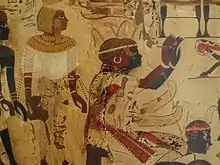
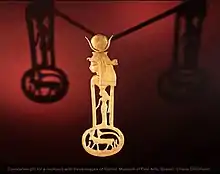
Resistance to the early eighteenth Dynasty Egyptian rule by neighboring Kush is evidenced in the writings of Ahmose, son of Ebana, an Egyptian warrior who served under Nebpehtrya Ahmose (1539-1514 BC), Djeserkara Amenhotep I (1514–1493 BC), and Aakheperkara Thutmose I (1493–1481 BC). At the end of the Second Intermediate Period (mid-sixteenth century BC), Egypt faced the twin existential threats—the Hyksos in the North and the Kushites in the South. Taken from the autobiographical inscriptions on the walls of his tomb-chapel, the Egyptians undertook campaigns to defeat Kush and conquer Nubia under the rule of Amenhotep I (1514–1493 BC). In Ahmose's writings, the Kushites are described as archers, "Now after his Majesty had slain the Bedoin of Asia, he sailed upstream to Upper Nubia to destroy the Nubian bowmen."[23] The tomb writings contain two other references to the Nubian bowmen of Kush. By 1200 BC, Egyptian involvement in the Dongola Reach was nonexistent.
Egypt's international prestige had declined considerably towards the end of the Third Intermediate Period. Its historical allies, the inhabitants of Canaan, had fallen to the Middle Assyrian Empire (1365-1020 BC), and then the resurgent Neo-Assyrian Empire (935–605 BC). The Assyrians, from the 10th century BC onwards, had once more expanded from northern Mesopotamia, and conquered a vast empire, including the whole of the Near East, and much of Anatolia, the eastern Mediterranean, the Caucasus and early Iron Age Iran.
Kingdom of Kush (1070 BC)
With the disintegration of the New Kingdom around 1070 BC, Kush became an independent kingdom centered at Napata in modern northern Sudan.[24] This more-Egyptianized "Kingdom of Kush" emerged, possibly from Kerma, and regained the region's independence from Egypt.
The extent of cultural/political continuity between the Kerma culture and the chronologically succeeding Kingdom of Kush is difficult to determine. The latter polity began to emerge around 1000 BC, 500 years after the end of the Kingdom of Kerma.
The Kushites buried their monarchs along with all their courtiers in mass graves. Archaeologists refer to these practices as the "Pan-grave culture".[25] This was given its name due to how the remains are buried. They would dig a pit and put stones around them in a circle.[26] Kushites also built burial mounds and pyramids, and shared some of the same gods worshiped in Egypt, especially Ammon and Isis. With the worshiping of these gods, the Kushites began to take some of the names of the gods as their throne names.[15]
The Kush rulers were regarded as guardians of the state religion and were responsible for maintaining the houses of the gods. Some scholars believe the economy in the Kingdom of Kush was a redistributive system. The state would collect taxes in the form of surplus produce and would redistribute to the people. Others believe that most of the society worked on the land and required nothing from the state and did not contribute to the state. Northern Kush seems to have been more productive and wealthier than the Southern area.[27]
Dental trait analysis of fossils dating from the Meroitic period in Semna, in northern Nubia near Egypt, found that they displayed traits similar to those of populations inhabiting the Nile, Horn of Africa, and Maghreb. Traits from mesolithic and southern Nubia around Meroe however indicated a closer affinity with other sub-Saharan dental records. It is indicative of a north-south gradient along the Nile river.[28]
Nubian conquest of Egypt (25th Dynasty)
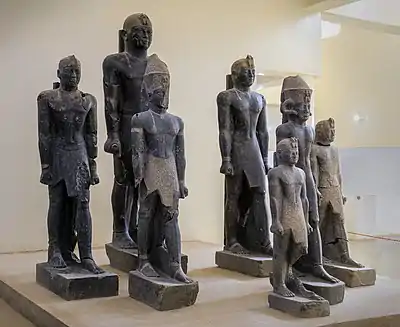
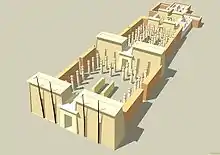
By the 8th century BC, the new Kushite kingdom emerged from the Napata region of the upper Dongola Reach. The first Napatan king, Alara founded the Napatan, or 25th, Kushite dynasty at Napata in Nubia, now Sudan. Alara dedicated his sister to the cult of Amun at the rebuilt Kawa temple, while temples were also rebuilt at Barkal and Kerma. A Kashta stele at Elephantine, places the Kushites on the Egyptian frontier by the mid-eighteenth century. This first period of the kingdom's history, the 'Napatan', was succeeded by the 'Meroitic', when the royal cemeteries relocated to Meroë around 300 BC.[30]
Alara's successor Kashta extended Kushite control north to Elephantine and Thebes in Upper Egypt. Kashta's successor Piye seized control of Lower Egypt around 727 BC.[31] Piye's 'Victory Stela', celebrating these campaigns between 728-716 BC, was found in the Amun temple at Jebel Barkal. He invaded an Egypt fragmented into four kingdoms, ruled by King Peftjauawybast, King Nimlot, King Iuput II, and King Osorkon IV.[32]:115,120
Why the Kushites chose to enter Egypt at this crucial point of foreign domination is subject to debate. Archaeologist Timothy Kendall offers his own hypotheses, connecting it to a claim of legitimacy associated with Jebel Barkal.[33] Kendall cites the Victory Stele of Piye at Jebel Barkal, which states that "Amun of Napata granted me to be ruler of every foreign country," and "Amun in Thebes granted me to be ruler of the Black Land (Kmt)". According to Kendall, "foreign lands" in this regard seems to include Lower Egypt while "Kmt" seems to refer to a united Upper Egypt and Nubia.[33]
Piye's successor, Shabaqo, defeated the Saite kings of northern Egypt between 711-710 BC and installed himself as king in Memphis. He then established ties with Sargon II.[32]:120 Piye's son, Taharqa's army undertook successful military campaigns, as attested by the "list of conquered Asiatic principalities" from the Mut temple at Karnak and "conquered peoples and countries (Libyans, Shasu nomads, Phoenicians?, Khor in Palestine)" from Sanam temple inscriptions.[34] Imperial ambitions of the Mesopotamian based Assyrian Empire made war with the 25th dynasty inevitable. In 701 BC, Taharqa and his army aided Judah and King Hezekiah in withstanding a siege by King Sennacherib of the Assyrians (2 Kings 19:9; Isaiah 37:9).[35] There are various theories (Taharqa's army,[36] disease, divine intervention, Hezekiah's surrender) as to why the Assyrians failed to take the city and withdrew to Assyria.[37] Torok mentions that Egypt's army "was beaten at Eltekeh" under Taharqa's command, but "the battle could be interpreted as a victory for the double kingdom", since Assyria did not take Jerusalem and "retreated to Assyria.[38]
The power of the 25th Dynasty reached a climax under Taharqa. The Nile valley empire was as large as it had been since the New Kingdom. New prosperity[14] revived Egyptian culture.[39] Religion, the arts, and architecture were restored to their glorious Old, Middle, and New Kingdom forms. The Nubian pharaohs built or restored temples and monuments throughout the Nile valley, including Memphis, Karnak, Kawa, and Jebel Barkal.[40][41] It was during the 25th dynasty that the Nile valley saw the first widespread construction of pyramids (many in modern Sudan) since the Middle Kingdom.[42][43][44] The Kushites developed their own script, the Meroitic alphabet, which was influenced by Egyptian writing systems c. 700–600 BC, although it appears to have been wholly confined to the royal court and major temples.[45]
Assyrian conquest of Egypt
.jpg.webp)
Taharqa initially defeated the Assyrians when war broke out in 674 BC. Yet, in 671 BC, the Assyrian King Esarhaddon started the Assyrian conquest of Egypt, took Memphis, and Taharqo retreated to the south, while his heir and other family members were taken to Assyria as prisoners. However, the native Egyptian vassal rulers installed by Esarhaddon as puppets were unable to effectively retain full control, and Taharqa was able to regain control of Memphis. Esarhaddon's 669 BC campaign to once more eject Taharqa was abandoned when Esarhaddon died in Palestine on the way to Egypt. Yet, Esarhaddon's successor, Ashurbanipal, did defeat Taharqa, and Taharqa died soon after in 664 BCE.[32]:121
Taharqa's successor, Tantamani sailed north from Napata, through Elephantine, and to Thebes with a large army to Thebes, where he was "ritually installed as the king of Egypt."[47] From Thebes, Tantamani began his reconquest[47] and regained control of Egypt, as far north as Memphis.[48] Tantamani's dream stele states that he restored order from the chaos, where royal temples and cults were not being maintained.[47] After defeating Sais and killing Assyria's vassal, Necho I, in Memphis, "some local dynasts formally surrendered, while others withdrew to their fortresses.[47]:185 Tantamani proceeded north of Memphis, invading Lower Egypt and, besieged cities in the Delta, a number of which surrendered to him. The Assyrians, who had a military presence in the Levant, then sent a large army southwards in 663 BC. Tantamani was routed, and the Assyrian army sacked Thebes to such an extent it never truly recovered. Tantamani was chased back to Nubia, but his control over Upper Egypt endured until c. 656 BC. At this date, a native Egyptian ruler, Psamtik I son of Necho, placed on the throne as a vassal of Ashurbanipal, took control of Thebes.[14][49] The last links between Kush and Upper Egypt were severed after hostilities with the Saite kings in the 590s BC.[32]:121–122
The Kushites used the animal-driven water wheel to increase productivity and create a surplus, particularly during the Napatan-Meroitic Kingdom.[50]
Achaemenid period
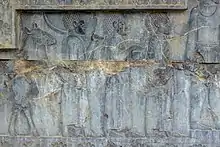
Herodotus mentioned an invasion of Kush by the Achaemenid ruler Cambyses (c. 530 BC). By some accounts Cambyses succeeded in occupying the area between the first and second Nile cataract,[51] however Herodotus mentions that "his expedition failed miserably in the desert."[48]:65–66 Achaemenid inscriptions from both Egypt and Iran include Kush as part of the Achaemenid empire.[52] For example, the DNa inscription of Darius I (r. 522–486 BC) on his tomb at Naqsh-e Rustam mentions Kūšīyā (Old Persian cuneiform: 𐎤𐎢𐏁𐎡𐎹𐎠, pronounced Kūshīyā) among the territories being "ruled over" by the Achaemenid Empire.[53][52] Derek Welsby states "scholars have doubted that this Persian expedition ever took place, but... archaeological evidence suggests that the fortress of Dorginarti near the second cataract served as Persia's southern boundary."[48]:65–66
Meroitic period (542 BC-4th century AD)
Kushite civilization continued for several centuries. According to Welsby, "throughout the Saite, Persian, Ptolemaic, and Roman periods, the Kushite rulers - the descendants of the XXVth Dynasty pharaohs, and the guardians of the Temple of Amun at Jebel Barkal[54] - could have pressed their 'legitimate' claim for control of Egypt and they thus posed a potential threat to the rulers of Egypt."[48]:66–67 Aspelta moved the capital to Meroë, considerably farther south than Napata, possibly c. 591 BC,[55] just after the sack of Napata by Psamtik II. Martin Meredith states the Kushite rulers chose Meroë, between the Fifth and Sixth Cataracts, because it was on the fringe of the summer rainfall belt, and the area was rich in iron ore and hardwood for iron working. The location also afforded access to trade routes to the Red Sea. The Kush traded iron products with the Romans, in addition to gold, ivory and slaves. Yet, the Butana plain was stripped of its forests, leaving behind slag piles.[56][57]
._Museum_of_Fine_Arts%252C_Boston.jpg.webp)
.jpg.webp)
In about 300 BC the move to Meroë was made more complete when the monarchs began to be buried there, instead of at Napata. One theory is that this represents the monarchs breaking away from the power of the priests at Napata. According to Diodorus Siculus, a Kushite king, "Ergamenes", defied the priests and had them slaughtered. This story may refer to the first ruler to be buried at Meroë with a similar name such as Arqamani,[58] who ruled many years after the royal cemetery was opened at Meroë. During this same period, the Kushite authority may have extended some 1,500 km along the Nile River valley from the Egyptian frontier in the north to areas far south of modern Khartoum and probably also substantial territories to the east and west.[59]
Ptolemaic period
There is no record of conflict between the Kushites and Ptolemies. However, there was a serious revolt at the end of Ptolemy IV and the Kushites likely tried to interfere in Ptolemaic affairs.[48]:67 It's suggested that this led to Ptolemy V defacing the name of Arqamani on inscriptions at Philae.[48]:67 "Arqamani constructed a small entrance hall to the temple built by Ptolemy IV at selchis and constructed a temple at Philae to which Ptolemy contributed an entrance hall."[48]:66 There's evidence of Ptolemaic occupation as far south as the 2nd cataract, but recent finds at Qasr Ibrim, such as "the total absence of Ptolemaic pottery" have cast doubts on the effectiveness of the occupation.[48]:67 Dynastic struggles led to the Ptolemies abandoning the area, so "the Kushites reasserted their control...with Qasr Ibrim occupied" (by the Kushites) and other locations perhaps garrisoned.[48]:67
Roman period
According to Welsby, after the Romans assumed control of Egypt, they negotiated with the Kushites at Philae and drew the southern border of Roman Egypt at Aswan.[48]:67 Theodor Mommsen and Welsby state the Kingdom of Kush became a client Kingdom, which was similar to the situation under Ptolemaic rule of Egypt. Kushite ambition and excessive Roman taxation are two theories for a revolt that was supported by Kushite armies.[48]:67–68 The ancient historians, Strabo and Pliny, give accounts of the conflict with Roman Egypt.
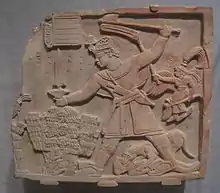
Strabo describes a war with the Romans in the first century BC. According to Strabo, the Kushites "sacked Aswan with an army of 30,000 men and destroyed imperial statues...at Philae."[48]:68 a "fine over-life-size bronze head of the emperor Augustus" was found buried in Meroe in front of a temple.[48]:68 After the initial victories of Kandake (or "Candace") Amanirenas against Roman Egypt, the Kushites were defeated and Napata sacked.[60] Remarkably, the destruction of the capital of Napata was not a crippling blow to the Kushites and did not frighten Candace enough to prevent her from again engaging in combat with the Roman military. In 22 BC, a large Kushite force moved northward with intention of attacking Qasr Ibrim.[61]:149
Alerted to the advance, Petronius again marched south and managed to reach Qasr Ibrim and bolster its defenses before the invading Kushites arrived. Welsby states after a Kushite attack on Primis (Qasr Ibrim),[48]:69–70 the Kushites sent ambassadors to negotiate a peace settlement with Petronius. The Kushites succeeded in negotiating a peace treaty on favorable terms.[60] Trade between the two nations increased[61]:149 and the Roman Egyptian border being extended to "Hiera Sykaminos (Maharraqa)."[48]:70 This arrangement "guaranteed peace for most of the next 300 years" and there's "no definite evidence of further clashes."[48]:70
It is possible that the Roman emperor Nero planned another attempt to conquer Kush before his death in AD 68.[61]:150–151 Nero sent two centurions upriver as far as Bahr el Ghazal River in 66 AD in an attempt to discover the source of the Nile, per Senecas,[56]:43 or plan an attack, per Pliny. Kush began to fade as a power by the 1st or 2nd century AD, sapped by the war with the Roman province of Egypt and the decline of its traditional industries.[62] However, there is evidence of 3rd century AD Kushite Kings at Philae in demotic and inscription.[48]:71 It's been suggested that the Kushites reoccupied lower Nubia after Roman forces were withdrawn to Aswan. Kushite activities led others to note "a de facto Kushite control of that area (as far north as Philae) for part of the 3rd century AD.[48]:71 Thereafter, it weakened and disintegrated due to internal rebellion. In the mid-4th century, Kush attacked Axum, perhaps in a dispute over the region's ivory trade. Axum responded with a large force, sacking Meroe and leading to the collapse of the civilization.[63] Christianity began to gain over the old pharaonic religion and by the mid-sixth century AD the Kingdom of Kush was dissolved.[27]
Language and writing

The Meroitic language was spoken in Meroë and Sudan during the Meroitic period (attested from 300 BC). It became extinct about 400 AD. It is uncertain to which language family the Meroitic language is related. Kirsty Rowan suggests that Meroitic, like the Egyptian language, belongs to the Afro-Asiatic family. She bases this on its sound inventory and phonotactics, which she argues are similar to those of the Afro-Asiatic languages and dissimilar from those of the Nilo-Saharan languages.[64][65] Claude Rilly proposes that Meroitic, like the Nobiin language, belongs to the Eastern Sudanic branch of the Nilo-Saharan family, based in part on its syntax, morphology, and known vocabulary.[66][67][68]
In the Napatan Period Egyptian hieroglyphs were used: at this time writing seems to have been restricted to the court and temples. From the 2nd century BC, there was a separate Meroitic writing system. The language was written in two forms of the Meroitic alphabet: Meroitic Cursive, which was written with a stylus and was used for general record-keeping; and Meroitic Hieroglyphic, which was carved in stone or used for royal or religious documents. It is not well understood due to the scarcity of bilingual texts. The earliest inscription in Meroitic writing dates from between 180–170 BC. These hieroglyphics were found engraved on the temple of Queen Shanakdakhete. Meroitic Cursive is written horizontally, and reads from right to left like all Semitic orthographies.[69] This was an alphabetic script with 23 signs used in a hieroglyphic form (mainly on monumental art) and in a cursive form. The latter was widely used; so far some 1278 texts using this version are known (Leclant 2000). The script was deciphered by Griffith, but the language behind it is still a problem, with only a few words understood by modern scholars. It is not as yet possible to connect the Meroitic language with other known languages.[45] For a time, it was also possibly used to write the Old Nubian language of the successor Nubian kingdoms.[70]
Technology, medicine, and mathematics
Technology
The natives of the Kingdom of Kush developed the Sakia which was called Kolē in the Kingdom.[71] The Sakia was developed during the Meroitic period to improve irrigation. The introduction of this machine had a decisive influence on agriculture especially in Dongola as this wheel lifted water 3 to 8 meters with much less expenditure of labor and time than the Shaduf, which was the previous chief irrigation device in the Kingdom. The Shaduf relied on human energy but the Sakia was driven by buffalos or other animals.[71] The people of Kerma, ancestors to the Kushites, built bronze kilns through which they manufactured objects of daily use such as razors, mirrors and tweezers.[72]

The Kushites invented reservoirs in the form of the Hafir, during the Meroitic period. 800 ancient and modern hafirs have been registered in the Meroitic town of Butana.[74] The functions of Hafirs were to catch water during the rainy season for storage, to ensure water is available for several months during the dry season as well as supply drinking water, irrigate fields, and water cattle.[74] The Great Reservoir near the Lion Temple in Musawwarat es-Sufra is a notable hafir built by the Kushites.[73][74]
Bloomeries and blast furnaces could have been used in metalworking at Meroë.[75] Early records of bloomery furnaces dated at least to 7th and 6th century BC have been discovered in Kush. It is known that the ancient bloomeries that produced metal tools for the Kushites produced a surplus for sale.[76][77][78]
Medicine
Nubian mummies studied in the 1990s revealed that Kush was a pioneer of early antibiotics.[79] Tetracycline was being used by Nubians, based on bone remains between 350 AD and 550 AD. The antibiotic was in wide commercial use only in the mid 20th century. The theory states that earthen jars containing grain used for making beer contained the bacterium streptomycedes, which produced tetracycline. Although Nubians were not aware of tetracycline, they could have noticed that people fared better by drinking beer. According to Charlie Bamforth, a professor of biochemistry and brewing science at the University of California, Davis, he said "They must have consumed it because it was rather tastier than the grain from which it was derived. They would have noticed people fared better by consuming this product than they were just consuming the grain itself."[80]
Mathematics
Based on engraved plans of Meroitic King Amanikhabali's pyramids, Nubians had a sophisticated understanding of mathematics as they appreciated the harmonic ratio. The engraved plans is indicative of much to be revealed about Nubian mathematics.[81] The ancient Nubians also established a system of geometry which they used in creating early versions of sun clocks.[82][83] During the Meroitic period in Nubian history, the Nubians used a trigonometric methodology similar to the Egyptians.[84]
Military
During the siege of Hermopolis in the 8th century BC, siege towers were built for the Kushite army led by Piye, in order to enhance the efficiency of Kushite archers and slingers.[85] After leaving Thebes, Piye's first objective was besieging Ashmunein. He gathered his army after their lack of success so far, and undertook the personal supervision of operations including the erection of a siege tower from which Kushite archers could fire down into the city.[86] Early shelters protecting sappers armed with poles trying to breach mud-brick ramparts gave way to Battering rams[85]
Bowmen were the most important force components in the Kushite military.[87] Ancient sources indicate that Kushite archers favored one-piece bows that were between six to seven feet long, with so powerful a draw strength that many of the archers used their feet to bend their bows. However, composite bows were also used in their arsenal.[87] Greek historian, Herodotus indicated that primary bow construction was of seasoned palm wood, with arrows made of cane.[87] Kushite arrows were often poisoned-tipped.[88] Elephants were occasionally used in warfare during the Meroitic period as seen in the war against Rome around 20 BC.[88]
Architecture
During the Bronze age, Nubian ancestors of the Kingdom of Kush built speoi (a speos is a temple or tomb cut into a rock face) between 3700 to 3250 BCE. This greatly influenced the architecture of the New kingdom.[90] Tomb monuments were one of the more recognizable expressions of Kushite architecture. Uniquely Kushite tomb monuments were found from the beginning of the empire, at el Kurru, to the decline of the Kingdom. These monuments developed organically from Middle Nile (e.g. A-group) burial types. Tombs became progressively larger during the 25th dynasty, culminating in Taharqa's underground rectangular building with "aisles of square piers...the whole being cut from the living rock."[48]:103 Kushites also created pyramids,[91][92] mud-brick temples (deffufa), and masonry temples.[93][94] Kushites borrowed much from Egypt, as it relates to temple design. Kushite temples were quite diverse in their plans, except for the Amun temples which all have the same basic plan.[48]:118 The Jebel Barkal and Meroe Amun temples are exceptions with the 150m long Jebel Barkal being "by far the largest 'Egyptian' temple ever built in Nubia."[48]:118 Temples for major Egyptian deities were built on "a system of internal harmonic proportions" based on "one or more rectangles each with sides in the ratio of 8:5"[48]:133[95] Kush also invented Nubian vaults.
Piye is thought to have constructed the first true pyramid at el Kurru. Pyramids are "the archetypal tomb monument of the Kushite royal family" and found at "el Kurru, Nuri, Jebel Barkal, and Meroe."[48]:105 The Kushite pyramids are smaller with steeper sides than northern Egyptian pyramids. The Kushites are thought to have copied the pyramids of New Kingdom elites, as opposed to Old and Middle Kingdom pharaohs.[48]:105–106 Kushite housing consisted mostly of circular timber huts with some apartment houses with several two-room apartments. The apartment houses likely accommodated extended families.
The Kushites built a stone-paved road at Jebel Barkal, are thought to have built piers/harbors on the Nile river, and many wells.[96]
Kush and Egyptology
On account of the Kingdom of Kush's proximity to Ancient Egypt — the first cataract at Elephantine usually being considered the traditional border between the two polities — and because the 25th dynasty ruled over both states in the 8th century BC, from the Rift Valley to the Taurus mountains, historians have closely associated the study of Kush with Egyptology, in keeping with the general assumption that the complex sociopolitical development of Egypt's neighbors can be understood in terms of Egyptian models.[97] As a result, the political structure and organization of Kush as an independent ancient state has not received as thorough attention from scholars, and there remains much ambiguity especially surrounding the earliest periods of the state. Edwards[97] has suggested that the study of the region could benefit from increased recognition of Kush as a state in its own right, with distinct cultural conditions, rather than merely as a secondary state on the periphery of Egypt.
Kushite images
_%252C_Kerma_Museum%252CSudan_(2).jpg.webp) Portrait of Taharqa, Kerma Museum
Portrait of Taharqa, Kerma Museum.jpg.webp) The "Archer King", an unknown king of Meroe, 3rd century BCE. National Museum of Sudan.
The "Archer King", an unknown king of Meroe, 3rd century BCE. National Museum of Sudan..jpg.webp) Copy of relief from Naqa depicting Amanitore (second from left), Natakamani (second from right) and two princes approaching a three-headed Apedemak.
Copy of relief from Naqa depicting Amanitore (second from left), Natakamani (second from right) and two princes approaching a three-headed Apedemak. Taharqa's shrine, Ashmolean museum in Oxford, UK
Taharqa's shrine, Ashmolean museum in Oxford, UK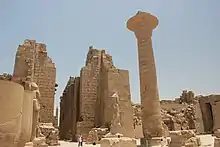 Taharqa's kiosk, Karnak Temple
Taharqa's kiosk, Karnak Temple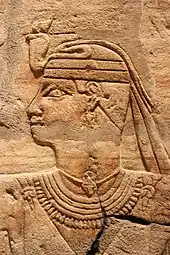 Pharaoh Taharqa of Ancient Egypt's 25th Dynasty. Ashmolean Museum, Oxford UK
Pharaoh Taharqa of Ancient Egypt's 25th Dynasty. Ashmolean Museum, Oxford UK
References
- Török 1998, p. 2 (1997 ed.).
- "Dive beneath the pyramids of Sudan's black pharaohs". National Geographics. 2 July 2019.
- "Dive beneath the pyramids of Sudan's black pharaohs". National Geographics. 2 July 2019.
- Török 1998, p. 49 (1997 ed.).
- Rilly, Claude (2019). "Languages of Ancient Nubia". In Raue, Dietrich (ed.). Handbook of Ancient Nubia. De Gruyter. pp. 133–4. ISBN 978-3110416695. Retrieved 2019-11-20.
The Blemmyan language is so close to modern Beja that it is probably nothing else than an early dialect of the same language.
- Society, National Geographic (2018-07-20). "The Kingdoms of Kush". National Geographic Society. Retrieved 2020-08-29.
- Alberge, Dalya. "Tomb reveals Ancient Egypt's humiliating secret". The Times. London.
- Török 1998, pp. 144–6.
- Stirn, Isma'il Kushkush, Matt. "Why Sudan's Remarkable Ancient Civilization Has Been Overlooked by History". Smithsonian Magazine. Retrieved 2020-08-23.
- Goldenberg, David M. (2005). The Curse of Ham: Race and Slavery in Early Judaism, Christianity, and Islam (New ed.). Princeton University Press. p. 17. ISBN 978-0691123707.
- Spalinger, Anthony (1974). "Esarhaddon and Egypt: An Analysis of the First Invasion of Egypt". Orientalia. Nova Series. 43: 295–326, XI.
- Allen, James P. (2013-07-11). The Ancient Egyptian Language: An Historical Study. Cambridge University Press. p. 53. ISBN 9781107032460. Retrieved 2015-04-15.
- Török 1998.
- Van, de M. M. A History of Ancient Egypt. Chichester, West Sussex: Wiley-Blackwell, 2011. Print.
- "GENESIS 10:10 KJV "And the beginning of his kingdom was Babel, and Erech, and Accad, and Calneh, in the land of Shinar."". www.kingjamesbibleonline.org.
- "PSALMS CHAPTER 7 KJV". www.kingjamesbibleonline.org.
- Török 1998, p. 69 ff (1997 ed.).
- Hafsaas-Tsakos, Henriette (2009). "The Kingdom of Kush: An African Centre on the Periphery of the Bronze Age World System". Norwegian Archaeological Review. 42 (1): 50–70. doi:10.1080/00293650902978590.
- Historical Dictionary of Ancient and Medieval Nubia, Richard A. Lobban Jr., p. 254.
- De Mola, Paul J. "Interrelations of Kerma and Pharaonic Egypt". Ancient History Encyclopedia: http://www.ancient.eu/article/487/
- "Jebal Barkal: History and Archaeology of Ancient Napata". Archived from the original on 19 September 2012. Retrieved 21 March 2012.
- Wilkinson, Toby (2016). Writings from Ancient Egypt. United Kingdom: Penguin Classics. p. 19. ISBN 978-0-141-39595-1.
- Morkot, Robert G. "On the Priestly Origin of the Napatan Kings: The Adaptation, Demise, and Resurrection of Ideas in Writing Nubian History" in O'Connor, David and Andrew Reid, eds. Ancient Egypt in Africa (Encounters with Ancient Egypt) (University College London Institute of Archaeology Publications) Left Coast Press (1 Aug 2003) ISBN 978-1-59874-205-3 p.151
- Pan Grave Culture – By K. Kris Hirst
- Archived 2013-10-24 at the Wayback Machine – By Manfred Bietak
- Welsby, Derek A. The Kingdom of Kush: the Napatan and Meroitic Empires. Princeton, NJ: Markus Wiener, 1998. Google Scholar. Web. 20 Oct. 2011
- Irish, Joel D. (1998). "Dental morphological affinities of Late Pleistocene through recent sub-Saharan and North African peoples" (PDF). Bulletins et Mémoires de la Société d'anthropologie de Paris. 10 (3): 237–272. doi:10.3406/bmsap.1998.2517. Retrieved 17 June 2017.
- Elshazly, Hesham. "Kerma and the royal cache". Cite journal requires
|journal=(help) - Edwards, David (2004). The Nubian Past. Oxon: Routledge. pp. 2, 75, 112, 114–117, 120. ISBN 9780415369886.
- Shaw (2002) p. 345
- Edwards, David (2004). The Nubian Past. Oxon: Routledge. pp. 2, 75, 77–78. ISBN 9780415369886.
- Kendall, T.K., 2002. Napatan Temples: a Case Study from Gebel Barkal. The Mythological Nubian Origin of Egyptian Kingship and the Formation of the Napatan State. Tenth International Conference of Nubian Studies. Rome, September 9–14, 2002.
- Török 1998, pp. 132-3, 153-84.
- Aubin, Henry T. (2002). The Rescue of Jerusalem. New York, NY: Soho Press, Inc. pp. x, 141–144. ISBN 1-56947-275-0.
- Aubin, Henry T. (2002). The Rescue of Jerusalem. New York, NY: Soho Press, Inc. pp. x, 127, 129–130, 139–152. ISBN 1-56947-275-0.
- Aubin, Henry T. (2002). The Rescue of Jerusalem. New York, NY: Soho Press, Inc. pp. x, 119. ISBN 1-56947-275-0.
- Török 1998, p. 170.
- Diop, Cheikh Anta (1974). The African Origin of Civilization. Chicago, Illinois: Lawrence Hill Books. pp. 219–221. ISBN 1-55652-072-7.
- Bonnet, Charles (2006). The Nubian Pharaohs. New York: The American University in Cairo Press. pp. 142–154. ISBN 978-977-416-010-3.
- Digital Collections, The New York Public Library. "(still image) Aethiopen. Barkal [Jebel Barkal]. Nördliche Pyramidengruppe. Pyr. 15: a. Nordwand; b. Westwand., (1849 - 1856)". The New York Public Library, Astor, Lenox, and Tilden Foundations. Retrieved August 20, 2020.
- Mokhtar, G. (1990). General History of Africa. California, USA: University of California Press. pp. 161–163. ISBN 0-520-06697-9.
- Emberling, Geoff (2011). Nubia: Ancient Kingdoms of Africa. New York: Institute for the Study of the Ancient World. pp. 9–11.
- Silverman, David (1997). Ancient Egypt. New York: Oxford University Press. pp. 36–37. ISBN 0-19-521270-3.
- "Meroitic script". www.digitalegypt.ucl.ac.uk.
- "Jebel Barkal guide" (PDF): 97–98. Cite journal requires
|journal=(help) - Török 1998, p. 185
- Welsby, Derek A. (1996). The Kingdom of Kush. London, UK: British Museum Press. pp. 64–65. ISBN 071410986X.
- Georges Roux – Ancient Iraq pp. 330–332
- William Y. Adams, Nubia: Corridor to Africa (Princeton University Press, 1977) 346-47, and William Y. Adams,
- Dandamaev, M. A. (1989). A Political History of the Achaemenid Empire. BRILL. pp. 80–81. ISBN 9004091726.
- Sircar, Dineschandra (1971). Studies in the Geography of Ancient and Medieval India. Motilal Banarsidass. p. 25. ISBN 9788120806900.
- Line 30 of the DNa inscription
- Digital Collections, The New York Public Library. "(still image) Aethiopen. Dynastie XXV, 3. Barkal [Jebel Barkal]. Grosser Felsentempel, Ostwand der Vorhalle., (1849 - 1856)". The New York Public Library, Astor, Lenox, and Tilden Foundations. Retrieved August 20, 2020.
- Festus Ugboaja Ohaegbulam (1 October 1990). Towards an understanding of the African experience from historical and contemporary perspectives. University Press of America. p. 66. ISBN 978-0-8191-7941-8. Retrieved 17 March 2011.
- Meredith, Martin (2014). The Fortunes of Africa. New York: Public Affairs. pp. 43–44. ISBN 9781610396356.
- Shillington, Kevin (2012). History of Africa. London: Palgrave Macmillan. pp. 50–51. ISBN 9780230308473.
- Fage, J. D.: Roland Anthony Oliver (1979) The Cambridge History of Africa, Cambridge University Press. ISBN 0-521-21592-7 p. 228
- Edwards, page 141
- Arthur E. Robinson, "The Arab Dynasty of Dar For (Darfur): Part II", Journal of the Royal African Society (Lond). XXVIII: 55–67 (October, 1928)
- Jackson, Robert B. (2002). At Empire's Edge: Exploring Rome's Egyptian Frontier. Yale University Press. ISBN 0300088566.
- "BBC World Service - The Story of Africa". www.bbc.co.uk.
- "Kingdom of Axum". Ancient History Encyclopedia. Retrieved 2020-12-10.
- Rowan, Kirsty (2011). "Meroitic Consonant and Vowel Patterning". Lingua Aegytia, 19.
- Rowan, Kirsty (2006), "Meroitic - An Afroasiatic Language?" SOAS Working Papers in Linguistics 14:169–206.
- Rilly, Claude; de Voogt, Alex (2012). The Meroitic Language and Writing System. Cambridge, UK: Cambridge University Press. ISBN 978-1107008663.
- Rilly, Claude (2004). "The Linguistic Position of Meroitic" (PDF). Sudan Electronic Journal of Archaeology and Anthropology. Archived from the original (PDF) on 2015-09-23. Retrieved 2017-11-02.
- Rilly, Claude (2016). "Meroitic". In Stauder-Porchet, Julie; Stauder, Andréas; Willeke, Wendrich (eds.). UCLA Encyclopedia of Egyptology. Los Angeles: UCLA.
- Fischer, Steven Roger (2004). History of Writing. Reaktion Books. pp. 133–134. ISBN 1861895887. Retrieved 16 January 2015.
- ""Meroe: Writing", Digital Egypt, University College, London". Digitalegypt.ucl.ac.uk. Retrieved 2012-09-06.
- Ki-Zerbo, J.; Mokhtar, G. (1981). Ancient civilizations of Africa. Unesco. International Scientific Committee for the Drafting of a General History of Africa. p. 309. ISBN 978-0435948054. Retrieved 2012-06-19.
- Bianchi 2004, p. 81.
- Näser, Claudia, "The Great Hafir at Musawwarat es-Sufra: Fieldwork of the Archaeological Mission of Humboldt University Berlin in 2005 and 2006.", In: Godlewski, Włodzimierz, Adam Łajtar (eds.), Between the Cataracts. Proceedings of the 11th Conference of Nubian Studies, Warsaw University, 27 August – 2 September 2006, Part two, fascicule 1: Session papers, PAM Suppl. Series 2.2/1. Warsaw 2010: 39-46., retrieved 2020-10-04
- Hintze 1963, pp. 222-4
- Humphris et al. 2018, p. 399.
- Collins, Robert O.; Burns, James M. (8 February 2007). A History of Sub-Saharan Africa. Cambridge University Press. ISBN 9780521867467.
- Edwards, David N. (29 July 2004). The Nubian Past: An Archaeology of the Sudan. Taylor & Francis. ISBN 978-0203482766.
- Humphris et al. 2018, pp. 399–416.
- Armelagos, George (2000). "Take Two Beers and Call Me in 1,600 Years: Use of Tetracycline by Nubians and Ancient Egyptians". Natural History. 109: 50–3. Retrieved 26 January 2021.
- Roach, John (17 May 2005). "Antibiotic Beer Gave Ancient Africans Health Buzz". National Geographic.
- Bianchi 2004, p. 230.
- Depuydt, Leo (1 January 1998). "Gnomons at Meroë and Early Trigonometry". The Journal of Egyptian Archaeology. 84: 171–180. doi:10.2307/3822211. JSTOR 3822211.
- Slayman, Andrew (27 May 1998). "Neolithic Skywatchers". Archaeology Magazine Archive. Archived from the original on 5 June 2011. Retrieved 17 April 2011.
- Neugebauer, O. (2004-09-17). A History of Ancient Mathematical Astronomy. Springer Science & Business Media. ISBN 9783540069959.
- "Siege warfare in ancient Egypt". Tour Egypt. Retrieved 23 May 2020.
- Dodson, Aidan (1996). Monarchs of the nile. American Univ. in Cairo Press. p. 178. ISBN 978-9774246005.
- Jim Hamm. 2000. The Traditional Bowyer's Bible, Volume 3, pp. 138-152
- Nicolle, David (26 March 1991). Rome's enemies. Illustrated by Angus McBride. London: Osprey. pp. 11–15. ISBN 1-85532-166-1. OCLC 26551074.
- "Gebel Barkal and the Sites of the Napatan Region". UNESCO - World Heritage Convention.
- Bianchi 2004, p. 227.
- Digital Collections, The New York Public Library. "(still image) Aethiopen. Begerauîeh [Begrawiya]. Pyramidengruppe A. Pyr. 9. Südwand., (1849 - 1856)". The New York Public Library, Astor, Lenox, and Tilden Foundations. Retrieved August 20, 2020.
- Digital Collections, The New York Public Library. "(still image) Aethiopen. Begerauîeh [Begrawiya]. Pyramidengruppe A. Pyr. 15. Pylon., (1849 - 1856)". The New York Public Library, Astor, Lenox, and Tilden Foundations. Retrieved August 20, 2020.
- Digital Collections, The New York Public Library. "(still image) Aethiopen. Naga [Naqa]. Tempel a. Vorderseite des Pylons., (1849 - 1856)". The New York Public Library, Astor, Lenox, and Tilden Foundations. Retrieved August 20, 2020.
- Digital Collections, The New York Public Library. "(still image) Aethiopen. Begerauîeh [Begrawiya]. Pyramidengruppe A. Pyr. 31. Pylon., (1849 - 1856)". The New York Public Library, Astor, Lenox, and Tilden Foundations. Retrieved August 20, 2020.
- Digital Collections, The New York Public Library. "(still image) Aethiopen. Begerauîeh [Begrawiya]. Pyramidengruppe A. Pyr. 14. Westwand., (1849 - 1856)". The New York Public Library, Astor, Lenox, and Tilden Foundations. Retrieved August 20, 2020.
- John Noble Wilford, "Scholars Race to Recover a Lost Kingdom on the Nile", New York Times (June 19, 2007)
- "David N. Edwards, "Meroe and the Sudanic Kingdoms", "Journal of African History" (UK). Vol. 39 No. 2 (1998), pp 175–193".
Bibliography
- Bianchi, Robert Steven (2004). Daily Life of the Nubians. Greenwood. ISBN 978-0313325014.
- Edwards, David N. (2004). The Nubian Past. London: Routledge. pp. 348 Pages. ISBN 0-415-36987-8.
- Fisher, Marjorie M.; Lacovara, Peter; Ikram, Salima; et al., eds. (2012). Ancient Nubia: African Kingdoms on the Nile. The American University in Cairo Press. ISBN 978-977-416-478-1.
- Hintze, Fritz (1963). "Musawwarat as Sufra. Preliminary Report on the Excavations of the Institute of Egyptology, Humboldt University, Berlin, 1961-62" (PDF). Kush: Journal of the Sudan Antiquities Service. Vol. XI. The Service.
- Humphris, Jane; et al. (June 2018). "Iron Smelting in Sudan: Experimental Archaeology at The Royal City of Meroe". Journal of Field Archaeology. 43 (5). doi:10.1080/00934690.2018.1479085.
- Leclant, Jean (2004). The empire of Kush: Napata and Meroe. London: UNESCO. pp. 1912 Pages. ISBN 1-57958-245-1.
- Oliver, Roland (1975). The Cambridge History of Africa Volume 3 1050 – c. 1600. Cambridge: Cambridge University Press. ISBN 0-521-20981-1.
- Oliver, Roland (1978). The Cambridge history of Africa. Vol. 2, From c. 500 BC to AD 1050. Cambridge: Cambridge University Press. ISBN 0-521-20981-1.
- Shillington, Kevin (2004). Encyclopedia of African History, Vol. 1. London: Routledge. pp. 1912 Pages. ISBN 1-57958-245-1.
- Török, László (1998). "The Kingdom of Kush: Handbook of the Napatan-Meroitic Civilization". Handbook of Oriental Studies. Section 1 the Near and Middle East. Leiden: Brill. ISBN 978-9004104488.
Further reading
- Baud, Michel (2010). Méroé. Un empire sur le Nil (in French). Officina Libraria. ISBN 978-8889854501.
- Breyer, Francis (2014). Einführung in die Meroitistik (in German). Lit. ISBN 9783643128058.
- Valbelle, Dominique; Bonnet, Charles (2006). The Nubian Pharaohs. The American University in Cairo Press. ISBN 978-9774160103.
- Yvanes, Elsa (2018). "Clothing the elite? Patterns of textile production and consumption in ancient Sudan and Nubia". Dynamics and Organisation of Textile Production in Past Societies in Europe and the Mediterranean. pp. 81–92.
External links
| Wikimedia Commons has media related to Kingdom of Kush. |
- Dan Morrison, "Ancient Gold Center Discovered on the Nile", National Geographic News
- "Civilizations in Africa: Kush", Washington State University
- African Kingdoms | Kush
- Ancient Sudan (Nubia) website
- Joseph Poplicha, "The Biblical Nimrod and the Kingdom of Eanna", Journal of the American Oriental Society, Vol. 49, (1929), pp. 303–317
- Kerma website Official website of the Swiss archeological mission to Sudan.

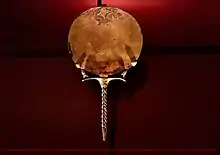
.jpg.webp)
